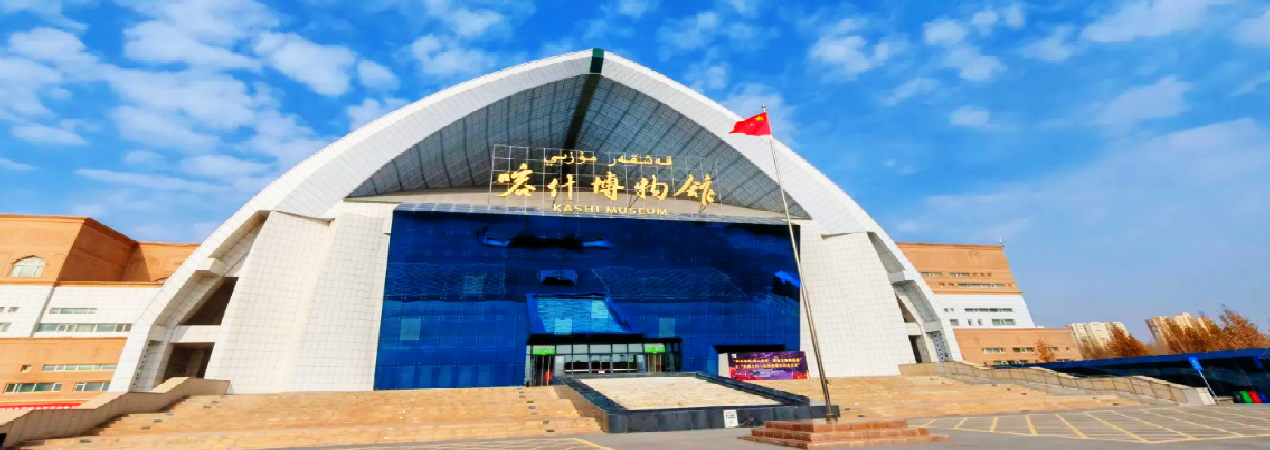Kashgar Museum

The Kashgar Museum is a condensation of Kashgar's long history. The museum boasts a rich collection of cultural relics, ranging from the late Paleolithic Age to modern times, with a total of more than 5,300 pieces (sets), including 63 precious ones.
- Chinese name: 喀什博物馆 Kāshí Bówùguǎn
- Suggested time: 1 - 2 hours
- Ticket: Free
- Open hours: Usually 10:00 - 21:00. However, it may be closed on Mondays and during some special holidays. It's advisable to check in advance.
- The best time to visit: All year around
- Address: Tianshan West Road, Kashgar City, Xinjiang Uygur Autonomous Region, China
- How to get there: Take Bus No. 28, get off at the Tourism Service Center Station, and walk about 300 meters to arrive.
Highlights of Kashgar Museum
There are currently four exhibition halls, namely: the Special Exhibition on the History, Ethnic Groups, and Religious Culture of Xinjiang, China; the Exhibition of Historical Relics of Kashgar- Kunlun River Basin and Treasures from Ancient Roads; the Exhibition of Kashgar Regional Planning; and the Exhibition of Fine Historical Relics from the Silk Road.
Special Exhibition on the History, Ethnic Groups, Religions and Culture of Xinjiang, China
The exhibition is located in the exhibition hall on the first floor, mainly presenting four aspects: the governance of Xinjiang by the central governments of successive dynasties in China, ethnic integration, religious coexistence, and cultural integration and development. Through rich exhibits and materials, it vividly demonstrates the integration of Xinjiang's diverse cultures.
Kunlun River Basin, Treasures from Ancient Roads — Exhibition of Kashgar's Historical Relics
This exhibition is located in the exhibition hall on the second floor, mainly displaying important cultural relics of Kashgar from the Paleolithic Age to various historical periods up to the socialist era. Through a large number of physical collections, scene reproductions, and documentary materials, the exhibition vividly demonstrates the profound cultural heritage of Kashgar.
Exhibition of Kashgar Regional Planning
This exhibition is located in the exhibition hall on the third floor, mainly showcasing the future development plans for Kashgar Prefecture. It adopts modern display methods such as 4D cinemas and interactive flying screens to present all aspects of Kashgar's future.
Exhibition of Fine Historical Relics from the Silk Road
Through the "Sketch Map of the Xinjiang Section of the Silk Road", the exhibition presents the folk customs and other cultural elements of the Kashgar region – where the middle and southern routes of the Xinjiang section of the Silk Road converge – spanning the prehistoric period, the Han and Tang dynasties, the Song and Yuan dynasties, and the Ming and Qing dynasties.
Important Exhibits
Three-ear Embossed Pottery Jar from the Northern Dynasties
This is the "treasure of the museum" of the Kashgar Museum. It is 57 cm high, 28 cm in caliber, and nearly 20 cm in bottom diameter. Its limited three-dimensional sense of space does not prevent it from condensing the complexity and exquisiteness of the patterns and releasing the diversity of exotic customs. The pottery statues of the Hu people on the jar are lifelike, and the abdomen is decorated with various figures, showing the life of the people in the Northern Dynasties.
Tang Dynasty Buddhist Sculpture
This is a Buddha head with thick eyebrows, slightly open eyes, clear eyebrows, regular facial features, a smile, and lifelike red lips. This exhibit shows the superb level of Buddhist sculpture art in the Tang Dynasty. It was collected from the Tuokuzi Salai site in Bachu County, showing the exquisite craftsmanship of Buddhist art in the Tang Dynasty.
Educational Value
Since its establishment in 1992, the Kashgar Museum has been committed to meeting the spiritual and cultural needs of citizens and improving their ideological and moral qualities and scientific and cultural quality. It has organically combined the functions of collection preservation, scientific research and publicity and education, and held various forms of exhibitions and social education activities, forming an exhibition and education system that complements basic exhibitions, temporary exhibitions, mobile museums and social education activities, showing the connotation of Kashgar's history and culture to the general public from multiple angles.
Activities to do at Kashgar Museum
Volunteer service: Teenagers can sign up to be volunteers and explain the stories behind cultural relics to visitors. In the process of providing guided tour services to the audience, they can exercise their language expression ability and enhance their understanding of Chinese culture.
Participating in social education activities: The museum holds social education activities on special occasions such as International Museum Day and the Spring Festival. Visitors can take part in activities like oil-paper umbrella painting, couplet writing and lantern making. They can also participate in knowledge quizzes about traditional festivals to experience the charm of traditional Chinese culture.
Drop us a line and we'll connect you with the top China expert in no time!